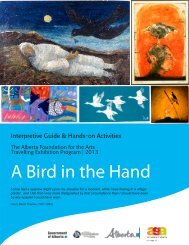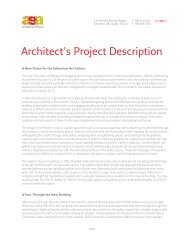Down on the Farm - Art Gallery of Alberta
Down on the Farm - Art Gallery of Alberta
Down on the Farm - Art Gallery of Alberta
- No tags were found...
Create successful ePaper yourself
Turn your PDF publications into a flip-book with our unique Google optimized e-Paper software.
The <strong>Alberta</strong> Foundati<strong>on</strong> for <strong>the</strong> <strong>Art</strong>s Travelling Exhibiti<strong>on</strong> ProgramPhotography and <strong>the</strong> Documentary EyeThere is a terrible truthfulness about photography.George Bernard ShawWhlle some photographers believed that photography should emulate painting, <strong>on</strong> <strong>the</strong>o<strong>the</strong>r side <strong>of</strong> <strong>the</strong> debate were those who believed that photography was primarliy apopular means <strong>of</strong> reproducing <strong>the</strong> material world. For all <strong>the</strong>ir ambiti<strong>on</strong>s, <strong>the</strong> artistphotographersremained a tiny group within <strong>the</strong> body photographic whereas it wasphotography’s capacity for recording fact, giving evidence, and presenting a documentthat practiti<strong>on</strong>ers and <strong>the</strong>ir public valued most. This aim <strong>of</strong> photographers to create a‘real’ document, which derived from <strong>the</strong> genre <strong>of</strong> realism in painting, resulted in <strong>the</strong> genre<strong>of</strong> DOCUMENTARY PHOTOGRAPHY and is most fully expressed in <strong>the</strong> exhibiti<strong>on</strong> <str<strong>on</strong>g>Down</str<strong>on</strong>g><strong>on</strong> <strong>the</strong> <strong>Farm</strong> in <strong>the</strong> work <strong>of</strong> Dawn Saunders Dahl.Documentary photography has been defined as ‘...adepicti<strong>on</strong> <strong>of</strong> <strong>the</strong> real world by a photographer whose intentis to communicate something <strong>of</strong> importance - to make acomment - that will be understood by <strong>the</strong> viewer.’ (Time LifeLibrary <strong>of</strong> Photography, pg. 12) In such photography <strong>the</strong>photographer attempts to produce truthful, objective, andusually candid photography <strong>of</strong> a particular subject, most<strong>of</strong>ten pictures <strong>of</strong> people.Dawn Saunders DahlLynn, 2008Digital photographCollecti<strong>on</strong> <strong>of</strong> <strong>the</strong> artistAs a genre <strong>of</strong> photography, documentary photographydeveloped in three general stages. While <strong>the</strong> actual term‘documentary photography’ was coined in <strong>the</strong> 1930s todescribe a category <strong>of</strong> photography which comments <strong>on</strong>reality, photographs meant to accurately describe o<strong>the</strong>rwiseunknown, hidden, forbidden, or difficult-to-access places orcircumstance date to <strong>the</strong> earliest daguerreotypes andcalotype surveys <strong>of</strong> <strong>the</strong> ruins <strong>of</strong> <strong>the</strong> Near East, Egypt, <strong>the</strong>historic architecture <strong>of</strong> Europe, and <strong>the</strong> Americanwilderness. This desire to create a permanent record <strong>of</strong>familiar and exotic scenes and <strong>the</strong> appearance <strong>of</strong>friends and family marked <strong>the</strong> first stage <strong>of</strong>documentary photography.As expressed by photographer John Thoms<strong>on</strong> in <strong>the</strong> 1860s...<strong>the</strong> photograph affords <strong>the</strong> nearest approach that can be made toward placing (<strong>the</strong> reader)actually before <strong>the</strong> scene which is represented’Documentary Photography, Time Life Library <strong>of</strong> Photography, pg. 16At this early stage in photography’s development, photographs were seen as miraculous,enabling <strong>the</strong> human eye to see things it did not always notice or would never see. Photographytook over <strong>the</strong> c<strong>on</strong>cerns with realism that had been developing in painting and <strong>the</strong> camerawas used mainly as a copier <strong>of</strong> nature. This faith in <strong>the</strong> camera as a literal recorder gave rise to<strong>the</strong> belief that <strong>the</strong> camera does not lie.AFA Travelling Exhibiti<strong>on</strong> Program, Edm<strong>on</strong>t<strong>on</strong>, AB. Ph: 780.428.3830 Fax: 780.421.0479youraga.ca
















